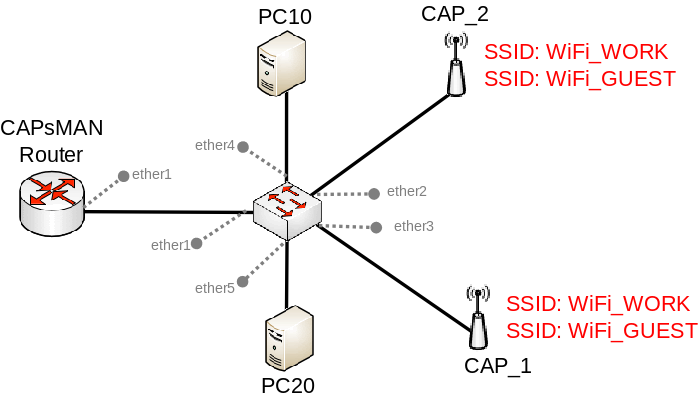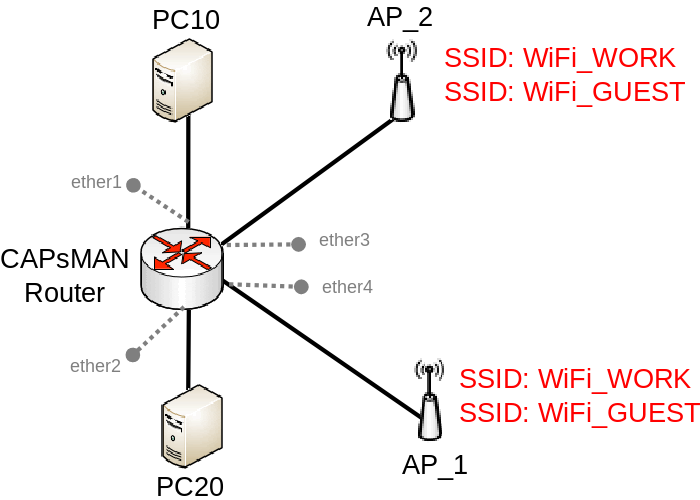Manual:CAPsMAN with VLANs: Difference between revisions
| Line 31: | Line 31: | ||
</pre> | </pre> | ||
{{ Note | You can create even more Virtual APs by adding multiple <var> | {{ Note | You can create even more Virtual APs by adding multiple <var>slave-confiugrations</var>. That requires multiple CAPsMAN configurations that were created earlier. }} | ||
* For security reasons, limit the CAPsMAN to a single interface | * For security reasons, limit the CAPsMAN to a single interface | ||
Revision as of 11:10, 16 August 2018
Summary
It is possible to create centralized Access Point management setup for home or office environment that is scalable to many Access Point, such a setup is quite easy to configure and has been explained in the Simple CAPSMAN setup guide, but for more complex setups VLANs might be required. CAPsMAN has a functionality to assign a certain VLAN ID under certain conditions. This guide will provide an example how assign a VLAN ID to Wireless packets based on the AP, to which a Wireless client connects to. CAPsMAN with VLANs can be achieved either by using Local Forwarding Mode or CAPsMAN Forwarding Mode, the Local Forwarding Mode will provide the possibility to use a switch between your APs and CAPsMAN router to switch packets (to achieve larger throughput), while CAPsMAN Forwarding Mode should be used when all traffic should always be forwarded to the CAPsMAN router (in most cases to filter packets).
In this example we are going to assign all our Wireless clients to VLAN10, if they connect to WiFi_WORK, and going to assign Wireless clients to VLAN20, if they connect to WiFi_GUEST. We are going to use Virtual APs along with CAPsMAN to create multiple SSIDs for our Wireless clients to connect to while using a single physical device. An example how to use a single SSID for a single physical device will also be shown by using CAPsMAN provisioning rules.
Using Local Forwarding Mode

CAPsMAN Router
- Create appropriate CAP configurations for each VLAN
/caps-man configuration
add country=latvia datapath.local-forwarding=yes datapath.vlan-id=10 datapath.vlan-mode=use-tag name=Config_WORK security.authentication-types=wpa-psk,wpa2-psk \
security.passphrase=secret_work_password ssid=WiFi_WORK
add country=latvia datapath.local-forwarding=yes datapath.vlan-id=20 datapath.vlan-mode=use-tag name=Config_GUEST security.authentication-types=\
wpa-psk,wpa2-psk security.passphrase=secret_guest_password ssid=WiFi_GUEST
- We are going to create a single CAPsMAN provisioning rule to create the WiFi_WORK and the WiFi_GUEST SSIDs on a single device, each connect CAP is going to create these SSIDs automatically
/caps-man provisioning add action=create-dynamic-enabled master-configuration=Config_WORK slave-configurations=Config_GUEST

Note: You can create even more Virtual APs by adding multiple slave-confiugrations. That requires multiple CAPsMAN configurations that were created earlier.
- For security reasons, limit the CAPsMAN to a single interface
/caps-man manager interface set [ find default=yes ] forbid=yes add disabled=no interface=ether1
- Enable the CAPsMAN manager
/caps-man manager set enabled=yes
- Setup DHCP Server for each VLAN
/interface vlan add interface=ether1 name=VLAN10 vlan-id=10 add interface=ether1 name=VLAN20 vlan-id=20 /ip address add address=192.168.10.1/24 interface=VLAN10 add address=192.168.20.1/24 interface=VLAN20 /ip pool add name=dhcp_pool10 ranges=192.168.10.2-192.168.10.254 add name=dhcp_pool20 ranges=192.168.20.2-192.168.20.254 /ip dhcp-server add address-pool=dhcp_pool10 disabled=no interface=VLAN10 name=dhcp10 add address-pool=dhcp_pool20 disabled=no interface=VLAN20 name=dhcp20 /ip dhcp-server network add address=192.168.10.0/24 dns-server=8.8.8.8 gateway=192.168.10.1 add address=192.168.20.0/24 dns-server=8.8.8.8 gateway=192.168.20.1
Switch
In this example we are going to be using Bridge VLAN Filering to filter unknown VLANs and to assign other devices to the same networks. Some devices are capable of offloading this to the built-in switch chip, check Basic VLAN switching guide to see how to configure it on different types of devices.
- Setup Bridge VLAN Filtering
/interface bridge add name=bridge1 vlan-filtering=yes /interface bridge port add bridge=bridge1 interface=ether1 add bridge=bridge1 interface=ether2 add bridge=bridge1 interface=ether3 add bridge=bridge1 interface=ether4 pvid=10 add bridge=bridge1 interface=ether5 pvid=20 /interface bridge vlan add bridge=bridge tagged=ether1,ether2,ether3 untagged=ether4,ether5 vlan-ids=10,20

Note: In this example untagged traffic is going to be used to communicate between CAPs and CAPsMAN Router. By default, if PVID is not changed, untagged traffic is going to be forwarded between ports that have the same PVID value set (including the default PVID).
CAPs
- Create a bridge and assign a port to it, that is connect to the CAPsMAN Router
/interface bridge add name=bridge1 /interface bridge port add bridge=bridge1 interface=ether1
- Enable CAP mode on the AP, make sure you specify to use the newly created bridge
/interface wireless cap set bridge=bridge1 discovery-interfaces=bridge1 enabled=yes interfaces=wlan1
That is it! Connect Wireless clients to your APs and check connectivity.
Using CAPsMAN Forwarding Mode

CAPsMAN Router
- Setup Bridge VLAN filtering to limit interfaces to appropriate VLANs
/interface bridge add name=bridge1 vlan-filtering=yes /interface bridge port add bridge=bridge1 interface=ether1 pvid=10 add bridge=bridge1 interface=ether2 pvid=20 /interface bridge vlan add bridge=bridge1 tagged=bridge untagged=ether1,ether2 vlan-ids=10,20

Note: CAPsMAN will attach CAP interfaces to the bridge and automatically will add appropriate entries to the bridge VLAN table.
- Create appropriate CAP configurations for each VLAN
/caps-man configuration
add country=latvia datapath.bridge=bridge1 datapath.vlan-id=10 datapath.vlan-mode=use-tag name=Config_WORK security.authentication-types=wpa-psk,wpa2-psk \
security.passphrase=secret_work_password ssid=WiFi_WORK
add country=latvia datapath.bridge=bridge1 datapath.vlan-id=20 datapath.vlan-mode=use-tag name=Config_GUEST security.authentication-types=wpa-psk,wpa2-psk \
security.passphrase=secret_guest_password ssid=WiFi_GUEST
- We are going to create a single CAPsMAN provisioning rule to create the WiFi_WORK and the WiFi_GUEST SSIDs on a single device, each connect CAP is going to create these SSIDs automatically
/caps-man provisioning add action=create-dynamic-enabled master-configuration=Config_WORK slave-configurations=Config_GUEST

Note: You can create even more Virtual APs by adding multiple slave-slave-confiugrations. That requires multiple CAPsMAN configurations that were created earlier.
- For security reasons, limit the CAPsMAN to interfaces. to which CAPs are going to be connected
/caps-man manager interface set [ find default=yes ] forbid=yes add disabled=no interface=ether3 add disabled=no interface=ether4
- Enable the CAPsMAN manager
/caps-man manager set enabled=yes
- Setup DHCP Server for each VLAN
/interface vlan add interface=bridge1 name=VLAN10 vlan-id=10 add interface=bridge1 name=VLAN20 vlan-id=20 /ip address add address=192.168.10.1/24 interface=VLAN10 add address=192.168.20.1/24 interface=VLAN20 /ip pool add name=dhcp_pool10 ranges=192.168.10.2-192.168.10.254 add name=dhcp_pool20 ranges=192.168.20.2-192.168.20.254 /ip dhcp-server add address-pool=dhcp_pool10 disabled=no interface=VLAN10 name=dhcp10 add address-pool=dhcp_pool20 disabled=no interface=VLAN20 name=dhcp20 /ip dhcp-server network add address=192.168.10.0/24 dns-server=8.8.8.8 gateway=192.168.10.1 add address=192.168.20.0/24 dns-server=8.8.8.8 gateway=192.168.20.1
CAPs
- Enable CAP mode on each AP, specify which interface is connected to the CAPsMAN router
/interface wireless cap set discovery-interfaces=ether1 enabled=yes interfaces=wlan1
That is it! Connect Wireless clients to your APs and check connectivity.
Case studies
Without Virtual APs
Not everyone wants to create Virtual APs since that does decrease the total throughput. If you want to use multiple devices to create multiple SSIDs, then it is possible to assign a certain configuration on a CAP based on its identity. To achieve this you should use CAPsMAN provisioning rules along with RegEx expressions. In this example we are going to assign the Config_WORK configuration to CAPs that have identity set to "'AP_WORK_*" and we are going to assign the Config_GUEST configuration to CAPs that have identity set to "AP_GUEST_*". To do this, you simply need to change the CAPsMAN provisioning rules.
- Remove any existing provisioning rules
/caps-man provisioning remove [f]
- Create new provisioning rules that will assign appropriate configuration on a CAP based on its identity
/caps-man provisioning add action=create-dynamic-enabled identity-regexp=^AP_GUEST_ master-configuration=Config_GUEST add action=create-dynamic-enabled identity-regexp=^AP_WORK_ master-configuration=Config_WORK

Note: Don't forget to set a proper identity on the CAPs since CAPsMAN is going to assign appropriate configuration on the APs based on it's identity.
